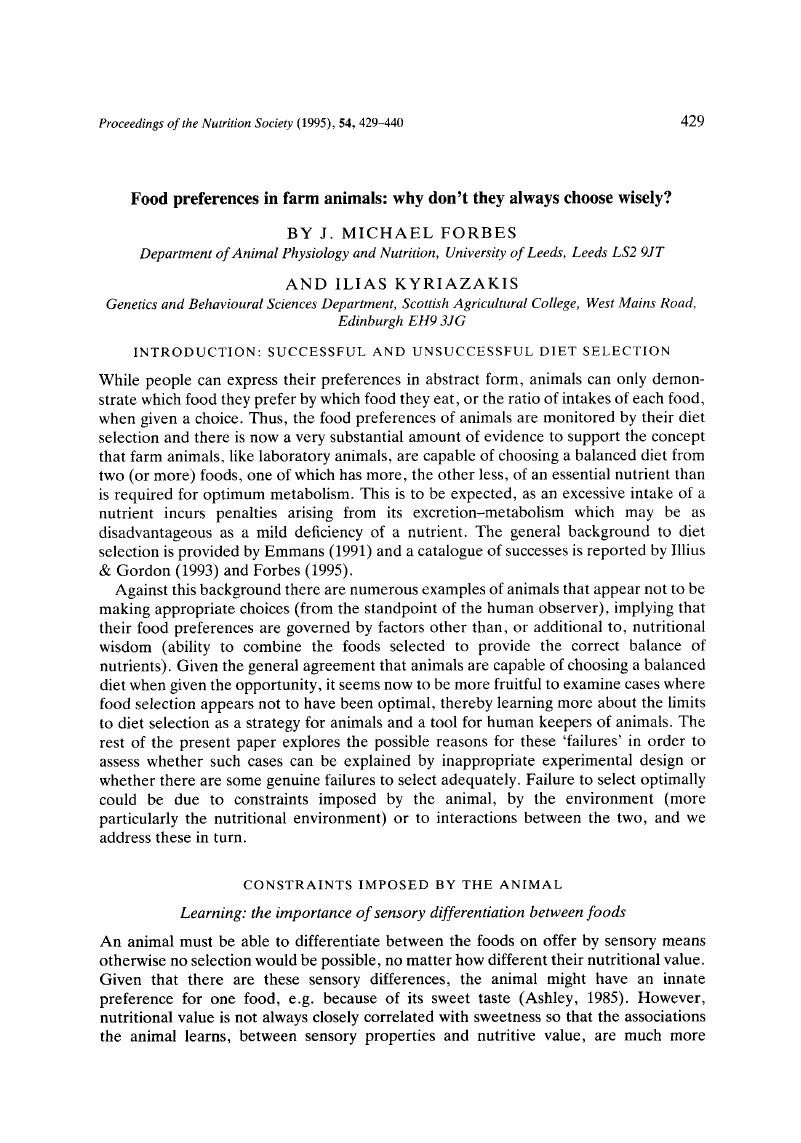Crossref Citations
This article has been cited by the following publications. This list is generated based on data provided by Crossref.
Lawrence, A. B.
and
Illius, A. W.
1997.
Measuring preferences and the problems of identifying proximate needs.
BSAP Occasional Publication,
Vol. 20,
Issue. ,
p.
19.
Tolkamp, B. J.
and
Kyriazakis, I.
1997.
Measuring diet selection in dairy cows: effect of training on choice of dietary protein level.
Animal Science,
Vol. 64,
Issue. 2,
p.
197.
MacLeod, M. G.
and
Dabutha, L. A.
1997.
Diet selection by Japanese quail (Coturnix coturnix japonica) in relation to ambient temperature and metabolic rate.
British Poultry Science,
Vol. 38,
Issue. 5,
p.
586.
Day, Jon E. L.
Kyriazakis, Ilias
and
Rogers, Peter J.
1998.
Food choice and intake: towards a unifying framework of learning and feeding motivation.
Nutrition Research Reviews,
Vol. 11,
Issue. 1,
p.
25.
Foster, L.A
Boeshore, K
and
Norgren, R
1998.
Intestinal fat suppressed intake of fat longer than intestinal sucrose.
Physiology & Behavior,
Vol. 64,
Issue. 4,
p.
451.
Duncan, Alan J.
and
Gordon, Iain J.
1999.
Habitat selection according to the ability of animals to eat, digest and detoxify foods.
Proceedings of the Nutrition Society,
Vol. 58,
Issue. 4,
p.
799.
Hills, J.
Kyriazakis, I.
Nolan, J.V.
Hinch, G.N.
and
Lynch, J.J.
1999.
Conditioned feeding responses in sheep to flavoured foods associated with sulphur doses.
Animal Science,
Vol. 69,
Issue. 2,
p.
313.
Kyriazakis, Ilias
Tolkamp, Bert J.
and
Emmans, Gerry
1999.
Diet selection and animal state: an integrative framework.
Proceedings of the Nutrition Society,
Vol. 58,
Issue. 4,
p.
765.
Arsenos, Georgios
Emmans, Gerry C.
and
Kyriazakis, Ilias
2000.
Variation between individuals and the consequences for diet selection by groups of animals.
Animal Behaviour,
Vol. 60,
Issue. 6,
p.
811.
Arsenos, G.
Hills, J.
and
Kyriazakis, I.
2000.
Conditioned feeding responses of sheep towards flavoured foods associated with casein administration: the rôle of long delay learning.
Animal Science,
Vol. 70,
Issue. 1,
p.
157.
Lawson, R. E.
Redfern, E. J.
and
Forbes, J. M.
2000.
Choices by lactating cows between concentrates high or low in digestible undegraded protein.
Animal Science,
Vol. 70,
Issue. 3,
p.
515.
Arsenos, G.
and
Kyriazakis, I.
2001.
The interactive effects of novel food flavours and food composition on the diet selection of sheep.
Proceedings of the British Society of Animal Science,
Vol. 2001,
Issue. ,
p.
61.
Arsenos, Georgios
and
Kyriazakis, Ilias
2001.
Does previous protein feeding affect the response of sheep towards foods that differ in their rumen availability, but not content, of nitrogen?.
Physiology & Behavior,
Vol. 72,
Issue. 4,
p.
533.
Forbes, J.M.
2001.
Consequences of feeding for future feeding.
Comparative Biochemistry and Physiology Part A: Molecular & Integrative Physiology,
Vol. 128,
Issue. 3,
p.
461.
Zervas, G.
Rissaki, M.
and
Deligeorgis, S.
2001.
Free-choice consumption of mineral lick blocks by fattening lambs fed ad libitum alfalfa hay and concentrates with different trace mineral content.
Livestock Production Science,
Vol. 68,
Issue. 2-3,
p.
251.
Fisher, Dwight S.
Mayland, Henry F.
and
Burns, Joseph C.
2002.
Variation in Ruminant Preference for Alfalfa Hays Cut at Sunup and Sundown1.
Crop Science,
Vol. 42,
Issue. 1,
p.
231.
Yeates, M. P.
Tolkamp, B. J.
and
Kyriazakis, I.
2002.
The relationship between meal composition and long-term diet choice1.
Journal of Animal Science,
Vol. 80,
Issue. 12,
p.
3165.
S̨ahin, Ahmet
Keskin, Mahmut
Biçer, Osman
and
Gül, Sabri
2003.
Diet selection by Awassi lambs fed individually in a cafeteria feeding system.
Livestock Production Science,
Vol. 82,
Issue. 2-3,
p.
163.
Hadjigeorgiou, I.E.
Gordon, I.J.
and
Milne, J.A.
2003.
Comparative preference by sheep and goats for Graminaeae forages varying in chemical composition.
Small Ruminant Research,
Vol. 49,
Issue. 2,
p.
147.
Morgan, C.A.
Kyriazakis, I.
Lawrence, A.B.
Chirnside, J.
and
Fullam, H.
2003.
Diet selection by groups of pigs: effect of a trained individual on the rate of learning about novel foods differing in protein content.
Animal Science,
Vol. 76,
Issue. 1,
p.
101.





